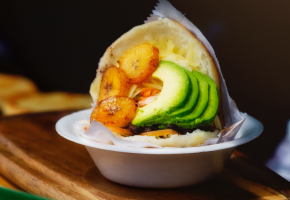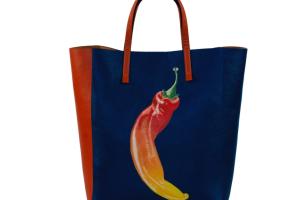Colombia is just North of the equator, and well within the tropics, so of course our climate is very different to Europe. Although we have two short rainy seasons each year, this usually just means that it rains torrentially for half an hour a day, then the sun comes out brilliantly again. The temperature depends entirely on altitude. My own origins are in the coffee-growing region of Risaralda, a mountainous area west of the capital Bogota. Where I grew up (the small town of Quinchia), you could hitch a lift in a jeep and be down by the lush banks of the Rio Cauca in a hour, basking in hot sun (>30C) any day of the year. If you went up the mountains into Los Nevados del Ruiz instead, you could be throwing snowballs within a couple of hours - as long as your chest could stand the altitude!
Exotic tropical fruits are available all the year round, not justmangoes, papaya and pineapple (which we eat super-fresh by the slice from street vendors all the year round), but alsoguava, maracuyá, and tomatillo. We love meat, and our beef (usually from zebu cattle, herds of which cover the mountain sides in some parts of the country) is every bit as good at Argentinian - though it tends not to get exported. Like the Spaniards, we also make full use of our pigs, and chorizos, morcilla and chicharrón (fresh hot crispy pork belly pieces) are hugely popular.

Colombia also has two coastlines - the Caribbean and the Pacific, and many huge rivers, including a stretch of the upper Amazon, so fish is excellent, very varied and always fresh. Trout is particularly popular, cooked with a variety of sauces, whilst various types of white fish are ideal for ceviche, the classic South American dish of raw fish marinated in citrus juices, mixed often with mild onion slices and a little sliced chili pepper, and garnished sometimes with fresh 'popped' corn kernels. This is an ideal party dish, as it can be prepared a couple of hours in advance, can be eaten just with a fork, and is zingy and appetising. On the Caribbean, coconut milk is often added to ceviche to give it a mild and fruity flavour. On the Pacific a stronger flavour of lime juice is typically preferred.

Like all cuisines, Colombian food has a starchy base. Potatoes come orginally from South America of course, and we have many types. Yuca - an African import - is another staple root vegetable. However rice is served with very many meals, and corn is particularly important. Instead of bread (at breakfast for instance) we usually have arepas - thick discs of reconstituted dried corn kernels, mashed with a little salt and then simply griddled. These are delicious straight off the griddle, spread with homemade butter or buttermilk, and perhaps topped with a slice or two of cheese, or some just-laid eggs from the chicken in yard which will typically have been cooked 'en caserola' - a bit like a cross between frying and poaching. If you have a stronger palate, some people swear by minced kidneys on top of arepas for breakfast. For a special treat, we enjoy arepa de choclo - these are made not with dried and reconstituted corn kernels, but with fresh sweetcorn which has been boiled, mashed, seasoned, then formed into thick patties - sweet, soft and slightly salty all at the same time, absolutely delicious when freshly grilled and buttered.

As in the UK, Christmas and the New Year are the time of year when families are reunited, though unlike you we usually have the benefit of doing this in lovely weather! Hence for us December and January are like Christmas, the New Year, July and August all rolled into one. Early in January, once the New Year celebrations are over, festivals and carnivals are held all over the country, but especially in Baranquilla, Manizales, and Pasto. The holidays seem to go on for weeks sometimes and large family groups seem to roam the country visiting far-flung relatives in all parts. Outdoor swimming pools and amusement parks all over the country are as busy as the beaches - and the bars. Personally I love to get out into the countryside horse-riding, especially it if means I can reach one of the more remote valleys, to enjoy swimming in one of our many natural thermal springs, or to eat fresh grilled trout fished out of the stream.
Everyone cooks. Many of the traditional Christmas specialities are ideal for getting children involved with their mothers, grandmothers and aunties in stirring natilla (a thick corn-based custard, flavoured with cinnamon). When set, but ideally still warm, natilla is served with buñuelos, fluffy sweet doughnuts with a slightly 'tangy' flavour which comes from being made with fresh (often homemade) mild white cheese. Tamales are another tradition at Christmas, and again ideal for sharing the effort. People 'muck in' to mix the corn dough, prepare the filling which is most often of chicken and vegetables, and wrap the assembled packages in banana leaves ready for steaming. Empanadas are also made in vast quantities - small 'pasties' which can be filled with shredded beef, or mushrooms and cheese, or almost anything! encased in a crispy fried cornmeal shell or a light flaky baked wheat pastry crust (very typical of Chile, but now also popular in the more tropical countries of the continent). These are always served with ají, a fresh relish of tomatoes, onions, chilis and lime juice which really gives these snacks some kick!

Parties are big of course. More than in the UK (it seems to me), all age groups get together collectively, to talk, to eat, to drink, and often to sing and, ofcourse, to dance! Live musicians often come to people's homes - it's very easy to hire a mariachi band in the big cities of the country. There will always be food, and in my experience there will always be a full hot meal for anyone who wants to sit down for that. Small groups will form to catch up on gossip over a plate of braised beef with potatoes, yuca and vegetables, crispy fried chicken, or mondongo (delicious spicy tripe stew), which will arrive unprompted like magic from the kitchen. Meanwhile most people will be chatting (or flirting) over drinks, whilst a continuous stream of snacks circulates - empanadas, chorizos, tamales, bunuelos, and maybe small plates of ceviche. The most traditional beverage in colombia by the way (apart from beer) is aguardiente, a aniseed-flavoured clear spirit, usually drunk neat. It is more than not an acquired taste for foreigners - thankfully the Latin American classics like Margaritas, Mojitos, and Caipirinhas are well known and usually expertly prepared.



















